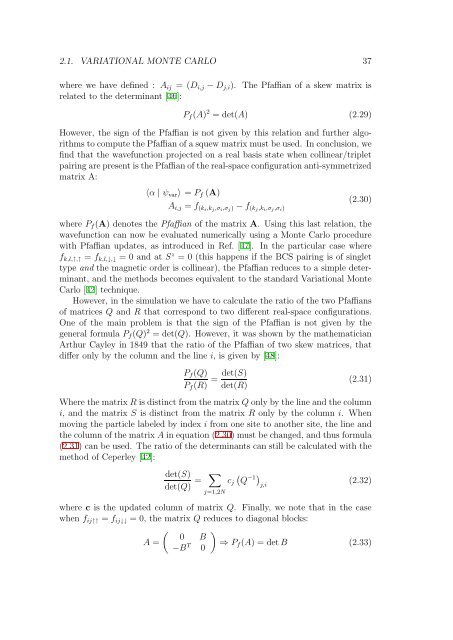pdf, 9 MiB - Infoscience - EPFL
pdf, 9 MiB - Infoscience - EPFL
pdf, 9 MiB - Infoscience - EPFL
You also want an ePaper? Increase the reach of your titles
YUMPU automatically turns print PDFs into web optimized ePapers that Google loves.
2.1. VARIATIONAL MONTE CARLO 37<br />
wherewehavedefined: A ij =(D i,j − D j,i ). The Pfaffian of a skew matrix is<br />
related to the determinant [46]:<br />
P f (A) 2 =det(A) (2.29)<br />
However, the sign of the Pfaffian is not given by this relation and further algorithms<br />
to compute the Pfaffian of a squew matrix must be used. In conclusion, we<br />
find that the wavefunction projected on a real basis state when collinear/triplet<br />
pairing are present is the Pfaffian of the real-space configuration anti-symmetrized<br />
matrix A:<br />
〈α | ψ var 〉 = P f (A)<br />
A i,j = f (ki ,k j ,σ i ,σ j ) − f (kj ,k i ,σ j ,σ i )<br />
(2.30)<br />
where P f (A) denotes the Pfaffian of the matrix A. Using this last relation, the<br />
wavefunction can now be evaluated numerically using a Monte Carlo procedure<br />
with Pfaffian updates, as introduced in Ref. [47]. In the particular case where<br />
f k,l,↑,↑ = f k,l,↓,↓ =0andatS z = 0 (this happens if the BCS pairing is of singlet<br />
type and the magnetic order is collinear), the Pfaffian reduces to a simple determinant,<br />
and the methods becomes equivalent to the standard Variational Monte<br />
Carlo [42] technique.<br />
However, in the simulation we have to calculate the ratio of the two Pfaffians<br />
of matrices Q and R that correspond to two different real-space configurations.<br />
One of the main problem is that the sign of the Pfaffian is not given by the<br />
general formula P f (Q) 2 =det(Q). However, it was shown by the mathematician<br />
Arthur Cayley in 1849 that the ratio of the Pfaffian of two skew matrices, that<br />
differ only by the column and the line i, is given by [48]:<br />
P f (Q)<br />
P f (R) = det(S)<br />
det(R)<br />
(2.31)<br />
Where the matrix R is distinct from the matrix Q only by the line and the column<br />
i, and the matrix S is distinct from the matrix R only by the column i. When<br />
moving the particle labeled by index i fromonesitetoanothersite,thelineand<br />
the column of the matrix A in equation (2.30) must be changed, and thus formula<br />
(2.31) can be used. The ratio of the determinants can still be calculated with the<br />
method of Ceperley [42]:<br />
det(S)<br />
det(Q) =<br />
∑<br />
j=1,2N<br />
c j<br />
(<br />
Q<br />
−1 ) j,i<br />
(2.32)<br />
where c is the updated column of matrix Q. Finally, we note that in the case<br />
when f ij↑↑ = f ij↓↓ = 0, the matrix Q reduces to diagonal blocks:<br />
( )<br />
0 B<br />
A =<br />
−B T ⇒ P<br />
0<br />
f (A) =detB (2.33)
















